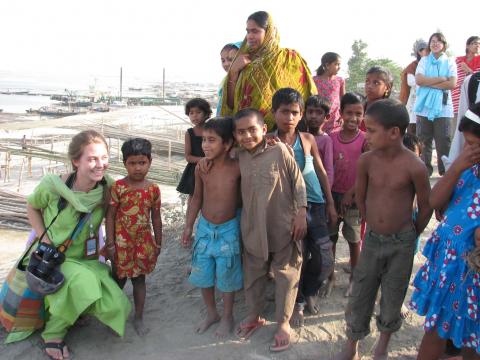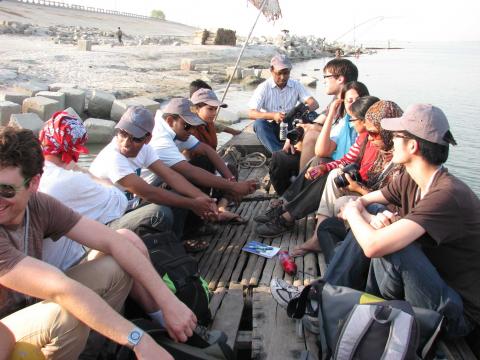Island-hopping in Bangladesh’s Brahmaputra River and wildlife-watching in the world’s largest mangrove forests hardly fits the traditional Spring Break experience, but for sustainable development major Fiona Kinniburgh ’13, there was no better place to be in spring 2012.
Kinniburgh was one of 13 undergraduates from Columbia College and the School of General Studies who spent 10 days in Bangladesh during Spring Break last year as part of the pilot course “Bangladesh: Life on a Tectonically Active Delta.” Lamont-Doherty Earth Observatory Research Professor Michael Steckler ’81 GSAS, who secured the grant that funded the trip, led the class through research projects in three areas: shrimp farming, urbanization and flooding.
 Undergraduates from Columbia College and the School of General Studies, including Fiona Kinniburgh ’13 (pictured above), spent 10 days in Bangladesh during Spring Break last year as part of the pilot course “Bangladesh: Life on a Tectonically Active Delta.” Photo: Michael Steckler
Undergraduates from Columbia College and the School of General Studies, including Fiona Kinniburgh ’13 (pictured above), spent 10 days in Bangladesh during Spring Break last year as part of the pilot course “Bangladesh: Life on a Tectonically Active Delta.” Photo: Michael Steckler
The course was designed for the increasingly popular College major in sustainable development. The interdisciplinary program, which draws upon the resources of the Earth Institute, launched in fall 2010 and gives students a survey of issues and strategies in the field of sustainable development, which, its website explains, “is founded on the premise that human well-being should advance without irreparable harm to ecosystems and the vital services they provide, without depleting essential resources, and without posing risks to future generations.” Climate change, energy resources and land use are all within the scope of this cutting-edge field.
With the assistance of graduate students from Dhaka University, who served as interpreters, Kinniburgh asked local villagers about their means of livelihood. “We wanted a local perspective on why they had switched to shrimp farming when most of them had been rice cultivators prior to that,” says Kinniburgh. “We wanted to know how the change in income had affected their lives.”
The course, which the program plans to offer again in spring 2014, fulfilled one of the major’s requirements, the Capstone Workshop, which typically pairs groups of students with public sector clients to develop solutions to sustainability problems in New York. In recent years, students have created lectures on climate change for NYC Urban Park Rangers to use with visitors; another group of students made recommendations for incorporating green spaces into an affordable housing complex for community members with special needs in the Bronx that is under construction. This semester, students analyzed the infrastructure of Rockland County, which was affected by Hurricanes Irene and Sandy, and suggested policy changes and other adaptations aimed at mitigating the impact of future storms.
Stuart Gaffin ’78, ’82 GSAS, adjunct associate professor in ecology, evolution and environmental biology and a scientist at the Earth Institute’s Center for Climate Systems Research, has been the adviser for the Capstone Workshop for several years and sees the value of such real-world opportunities. “It’s meant to simulate what you would encounter in your first job in sustainable development,” says Gaffin. “These are actual problems the clients are facing. They can be difficult and complex. That’s intended to be part of the experience.”
“We want students to understand the complexity of the world that we live in...” — Ruth DeFries
Taken in the junior or senior year, the Capstone Workshop encourages students to apply the skills and methods learned through the major’s other required coursework, which includes three foundation courses, a quantitative course and courses in the natural and social sciences. Majors must complete a total of 15 courses and a practicum.
Ruth DeFries, the Denning Family Professor of Sustainable Development and chair of the Department of Ecology, Evolution and Environmental Biology, was among the faculty members who designed the major. “We want students to understand the complexity of the world that we live in from an environmental perspective, a social perspective and an economic perspective, and to be able to look at the big issues that society is dealing with — climate change being a primary example — from these multiple perspectives,” she says.
A selection of courses was created specifically for the major, including those in the “Analysis and Solutions to Complex Problems” category. Courses in this area include “Global Food Systems,” “Disasters and Development” and “Climate Change and Law.” “We wanted courses that would address issues of sustainability from multiple perspectives within the course itself,” says DeFries.
 Students from Columbia and the University of Dhaka tour the damaged embankment at Sirajganj from the river. Photo: Michael Steckler
Students from Columbia and the University of Dhaka tour the damaged embankment at Sirajganj from the river. Photo: Michael Steckler
While some of these courses are open to students from all of Columbia’s schools, the sustainable development major is only open to College and General Studies students, who also have the option of a special concentration in sustainable development. Offered since fall 2007, the special concentration requires nine courses and a practicum.
In each of the past three years, 20–25 College and General Studies students have declared majors in sustainable development, while another 10–15 students have signed up for the special concentration. The program currently has 81 majors and 51 special concentrators, of which more than 100 are College students.
The special concentration and major are supported by a gift from Barbara and Joseph Ellis '64, and DeFries' chair is supported by a major gift from Steve and Roberta Denning.
For Patrick Woolsey ’13, the special concentration in sustainable development is the perfect accompaniment to his political science degree. “The political science major allows me to pursue my interest in policy and politics within a more traditional academic discipline,” says Woolsey, who plans to attend law school. “The sustainable development program has other strengths; it’s interdisciplinary and it’s a great way to look at environmental issues from a variety of perspectives.”
All students in the program are invited to brown bag events featuring professionals in the field and excursions around the New York City area. Students have visited, among other places, the Newtown Creek Wastewater Treatment Plant and the Gowanus Canal and Watershed in Brooklyn.
Some of the program’s graduates opt to continue their studies and pursue advanced degrees not only in sustainable development but also in law, medicine and public policy. Alumni have also gone on to work for a wide range of private, public and nonprofit employers, including Unilever, the New York City Department of Parks and Recreation, the Environmental Defense Fund and the Clinton Global Initiative.
Regardless of their post-graduation plans, the program’s goal is to equip students with the knowledge and skills required to address the most critical challenges of the 21st century. “These issues that we face are so relevant and so complex that they require a kind of systems thinking,” says DeFries. “We think it’s important for students to start this kind of systems thinking as undergraduates.”
— Nathalie Alonso ’08